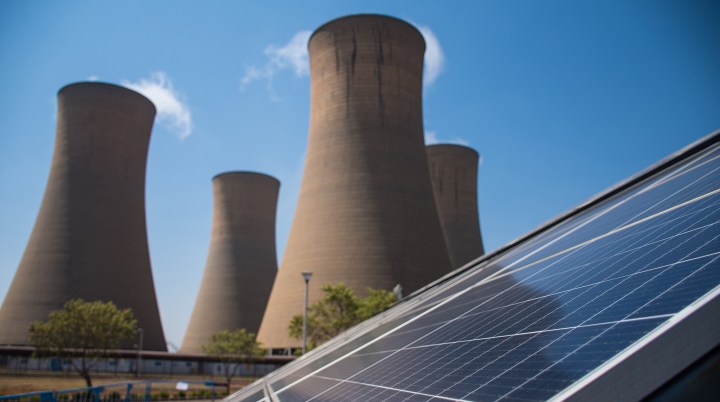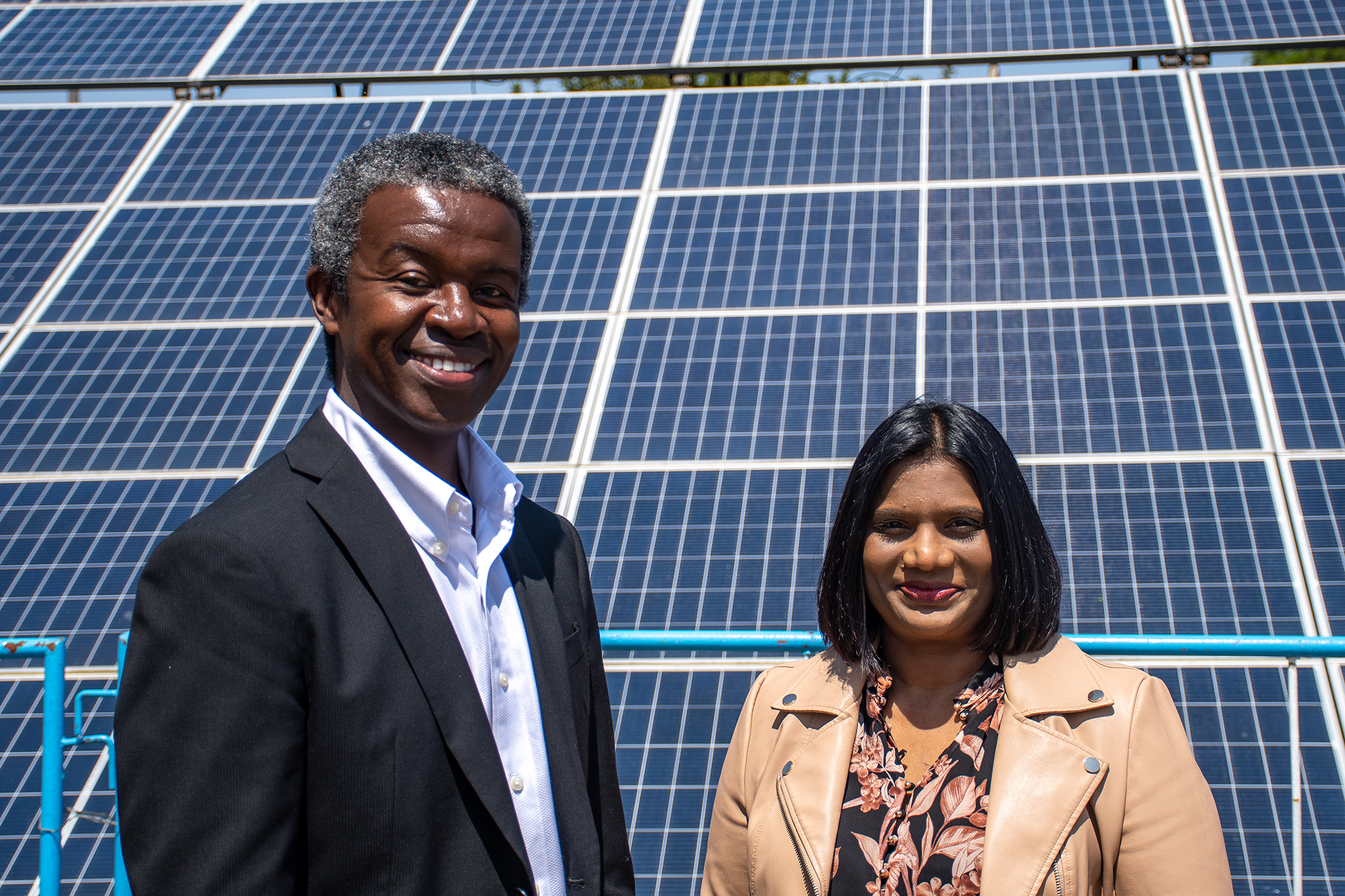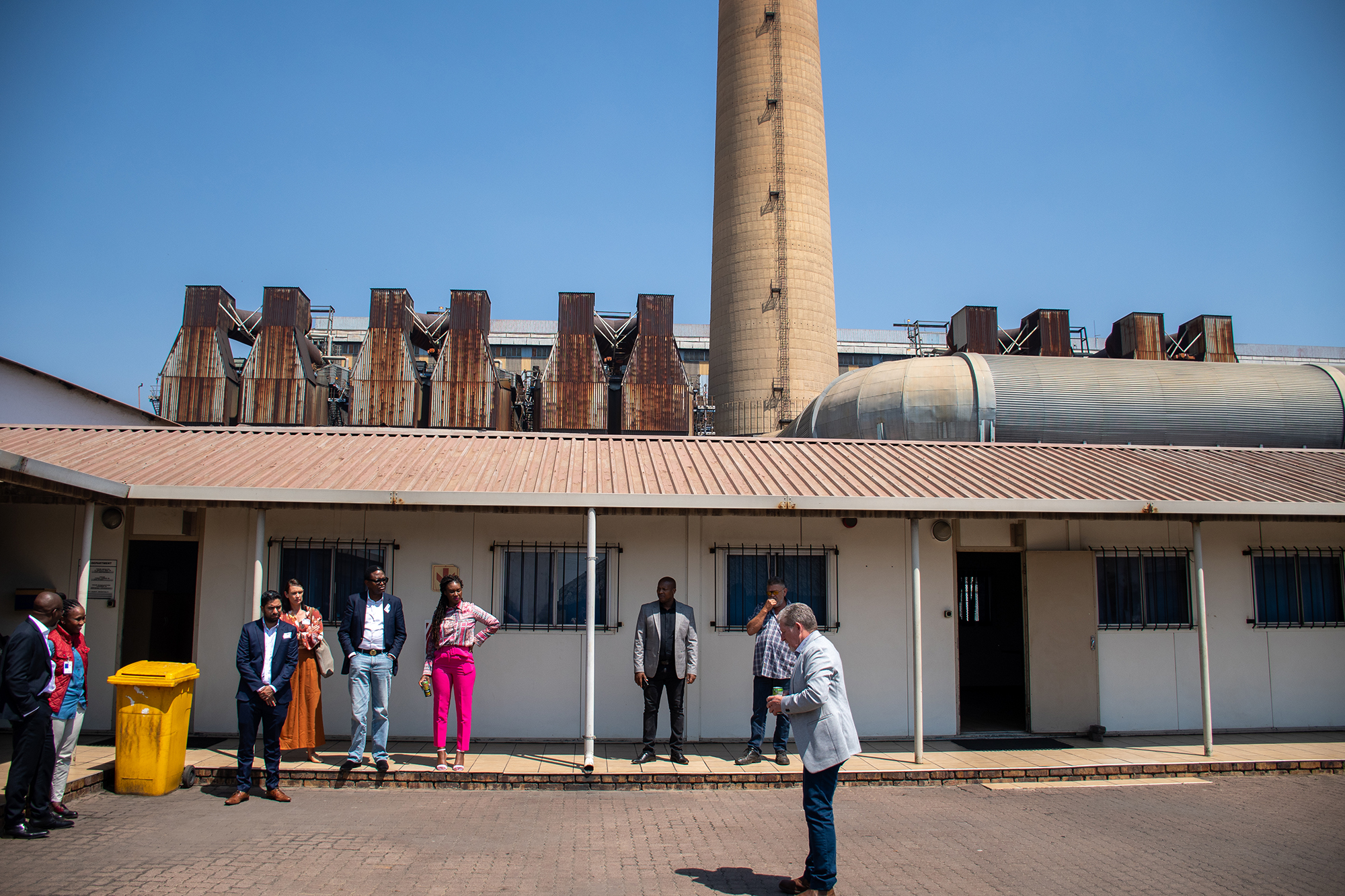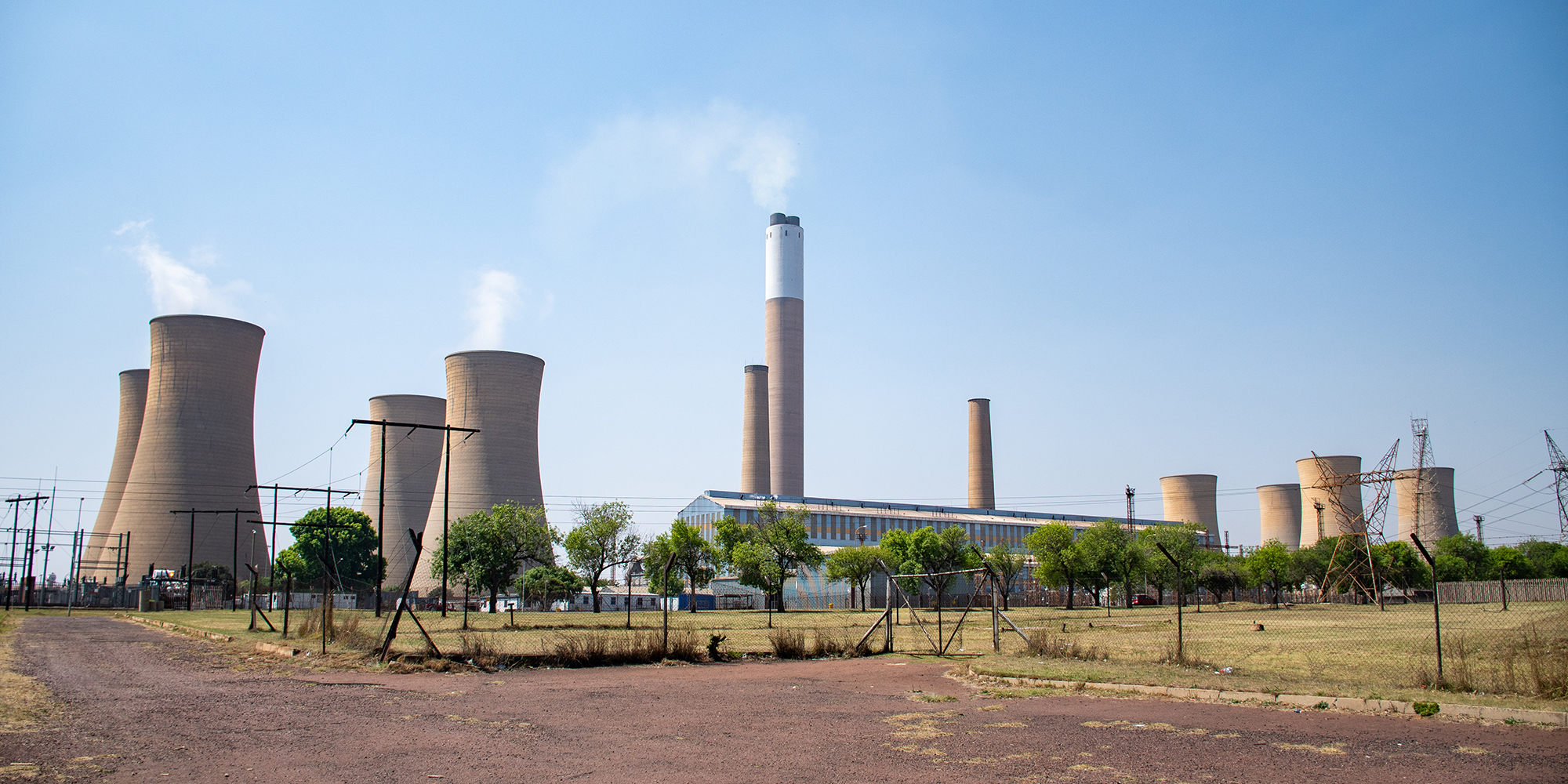JUST TRANSITION PROJECT
Shut-down Komati Power Station first of its kind to be repurposed into renewable energy training facility

After decades of producing energy from coal, the Komati Power Station is being repurposed as a renewable energy training facility and will be repowered by renewable technology in a massive transition project
‘I’m sure there’s a lot of people that are asking, why are we here, talking about shutting down a plant in the next month when we’re in the middle of load shedding,” said Mandy Rambharos, general manager of the Just Energy Transition programme at Eskom, at the signing ceremony for the development of renewable energy skills at the Komati Power Station, in Mpumalanga, on Friday.
“And I think what’s very important to understand is that we have a plan.”
The Komati Power Station is a coal-fired plant that started operating in the 1960s, and finally — after temporarily being shut between 1990 and 2009 — is being shut for good.
But Eskom’s plan, part of the just energy transition (JET), is to repower Komati with renewable energy (150MW of solar, 70MW of wind and 150MW of batteries), and repurpose it into a training facility to reskill and upskill Eskom employees and the surrounding community to be able to operate renewable energy facilities, and as a factory for the assembling of containerised solar microgrids that will be dispersed across South Africa.
The plan is about ensuring ghost towns are not left behind after shutting down a plant.
There are 600 employees at Komati Power Station — 200 permanent staff, 200 contractors and 200 ERI Eskom road tech industry contractors.
Rambharos said they are not retrenching any of the full-time Eksom employees — they will be reskilled and redeployed at the training facility.
“A just energy transition plan is not about shutting plants overnight, it is about a phased and timed transition of our coal plants over time,” said Rambahros. She said they would be returning economic value to the communities where the plant is shutting down, and that, taking into consideration the entire value chain and the supply chain from building renewables, they would, on a net basis, create more jobs.
Mpumalanga is battling with unemployment — the official unemployment rate for the province is 38%, with 58% youth unemployment, and 66% of women affected by unemployment.
Jurie Pieterse, the general manager at the Komati Power Station, noted that this JET programme comes after President Cyril Ramaphosa’s announcement in June that the government would use climate funding provided through the Just Energy Transition Partnership to invest in the grid and repurpose power stations that had reached the end of their lifespans.
Additionally, in 2021 the government raised the licensing threshold for new embedded generation projects from 1MW to 100MW, which has allowed projects like this to happen and has unlocked more than 80 confirmed private sector projects with a combined capacity of more than 6,000MW.
Komati has one remaining unit (125MW) out of its original nine, which will be shut down at the end of this month.

Joseph Nganga, executive director for Africa of GEAPP, with general manager of Eskom’s Just Energy Transition Office Mandy Rambharos in front of a containerised solar micro grid on display at Komati Power Station. (Photo: Julia Evans)
Why Mpumalanga needs to remain the energy hub
“Our vision for Mpumalanga is that it will continue to be the energy hub for South Africa,” said Rambharos, acknowledging that many people don’t believe that there are enough wind resources in Mpumalanga for it to remain an energy hub.
She said, however, Mpumalanga was living up to its name, which means “place of the rising sun”, as it does have solar and wind resources.
“And, extremely importantly, we have people resources in Mpumalanga.”
Peter Venn, the managing director of Windlab Africa, said keeping Mpumalanga as South Africa’s energy hub makes sense.
“Mpumalanga, geographically, is perfectly located to provide Gauteng and the greater area around Gauteng with demand,” said Venn.
“I have got [renewable] tech in the Northern Cape, Western and Eastern Cape, but we need more generation closer to where the demand is. Mpumalanga is the heartbeat of the energy generation of South Africa, and that’s not going to change — we can’t allow it to change.”
Eskom and the office of the independent power producers (IPP) have attributed grid challenges (not having enough capacity on the grid in other provinces) to delays in getting renewable IPP builds on the ground.
Venn said that he had recently conducted a transaction with Seriti Resources (a key coal supplier for SA), whereby Venn and Seriti bought the majority stake in renewable energy developer Windlab from Australia, creating the largest black independent power producer in South Africa.
Additionally, they will begin construction on a 900MW renewable energy facility next to the Tutuka Power Station in March.
“From a just energy transition perspective, it is a fantastic investment into the province,” said Venn at the signing ceremony. “There will be thousands of jobs created through the construction period. And we will be constructing more than three gigawatts of wind energy over the next 10 years.”
However, Venn said that this doesn’t mean they are abandoning coal.
“Eighty percent or more of our power comes from coal generation. And that’s going to continue.
“We need additional kilowatt-hours to grow GDP and to grow jobs in this country. So it’s not about taking away. Mpumalanga is in the position to have both coal and renewable energy — it’s not one or the other.”

General manager of Komati Power Station Jurie Pieterse on a site tour to show stakeholders how old classrooms will be used for teaching when Komati is repurposed into a renewable energy training centre. (Photo: Julia Evans)
Visit Daily Maverick’s home page for more news, analysis and investigations
The training facility
“When we talk to our colleagues in the wind and solar industry, they say to us that even if we implement the IRP [Integrated Resource Plan] as it stands now, we do not have enough skills in the country for the renewables value chain,” said Rambharos, which was met with nods around the room from energy experts.
“So, launching this skills training facility is part of meeting that need — how do we retrain, upskill and skill our people at Eskom, but also people in the community to be able to participate in these new value streams, and new change that we are creating?”
The training facility is the “repurposing” part of Eskom’s Komati Repowering and Repurposing Project, which Eskom says, “is one of the largest coal-fired power plant decommissioning, repowering and repurposing projects globally and will provide a tangible case-study for the world on how to transition fossil-fuel assets”.
Rambharos said: “In terms of shutting down a coal-fired power station of this magnitude — not just locking the door and throwing away the keys, actually having a very set plan in terms of the repowering, repurposing, the training — is the first of its kind.”
Eskom is partnering with the South African Renewable Energy Technology Centre (Saretec), which will run the training, and the Global Energy Alliance for People and Planet (Geapp), which is providing the funding of $2-million over the next two years of the programme.
The goal is to train 500 workers, some of them existing Eskom workers and some community members in Mpumalanga.
Rambharos said the JET office had been looking for partners to fund the programme for years, and now they have a completely grant-funded opportunity that they don’t have to pay back.
Saretec will educate, reskill and upskill Eskom Komati Power Station staff and qualifying beneficiaries from the surrounding communities in Mpumalanga so they can participate in the renewable value chain.
Saretec is based at the Cape Peninsula University of Technology’s Bellville campus in Cape Town and has trained hundreds of technicians in niche renewable energy skills since it began operating in 2016.
Upon completion, the training centre will be managed by Eskom’s Academy of Learning, which will be supported by Saretec to achieve accreditation over time, enabling Eskom to replicate this initiative in other locations.
Joseph Nganga, the executive director for Africa of Geapp, said the retraining and upskilling would “mitigate the risk of job losses related to the decommissioning of coal-fired power stations and create new job opportunities, particularly for unemployed young people. The Komati Training Facility will serve as a blueprint for how these training requirements can be fulfilled.”
Geapp was formed by three philanthropic organisations — Bezos Earth Fund, the Ikea Foundation and The Rockefeller Foundation — at the last UN climate change conference (COP26), and has 18 alliance members, including the World Bank and the African Development Bank.
“We formed because we believe that big philanthropy has a role to play in energy access, energy transition and the climate space,” Nganga told Our Burning Planet.
Venn said: “We look forward to using this centre, we look forward to sending lots of people on training. There are going to be numerous jobs across the value chain — we’re installing all three technologies: wind, solar PV and battery storage. So we’re able to provide that … base load … we are able to provide a much more steady generation profile into the province.”

Komati Power Station in Mpumalanga will be shut as a coal-fired plant and repurposed as a renewable energy training facility and repowered by renewable technology, as part of Eskom’s just energy transition programme. (Photo: Julia Evans)
Assembling solar microgrids
The other part of repurposing is creating a factory to assemble containerised solar microgrids.
Nick Singh, from Eskom’s Research, Testing and Development Centre, said they would repurpose Komati by building and repurposing legacy parts of the power station.
Komati’s Pieterse said the original turbine workshops would be used as microgrid workshops because they already have the infrastructure that can be used as a manufacturing plant for the microgrids.
Nganga said: “So the process is design and assembly … how you assemble it, how you configure it, how you optimise it — so there is no hugely innovative technology in this.”
“We’re going to use local artisans, welders, fabricators, electricians [on the assembly line,]” said Singh.
“And the truth of the matter is, we have very qualified electricians that are welding boilers and control systems — the same skill can come in here and wire this,” said Singh pointing at a containerised microgrid that was displayed at the signing ceremony.
“We have got fabricators and welders that now weld tube leaks in the boiler. It’s the same welding technique to weld these brackets.”
Singh explained that containerised microgrids are designed for electrification and are ideal for areas where there are sparsely populated villages that are far from the traditional network.
“It costs way too much money to implement conventional lines — so this system can now be put in those situations, where one of these containers can now power up to 40 local houses, for the next 20-plus years.”
These grids will be built at Komati, on an assembly line, and then transported to other parts of the country.
“This container can function in both on- and off-grid mode, which means it doesn’t need a grid (decentralised), but it can also be grid-tied,” explained Singh.
“So when the systems are grid-tied it offers a whole new suite of services, such as grid flexibility.”
Repowered with renewables
The mayor of Steve Tshwete Local Municipality, Petros Mhlonishwa Masilela, said: “As a municipality, we are paying on time, we don’t deserve to get load shedding.”
The Komati Power Station will be repowered with 150MW of solar, 70MW of wind and 150MW of batteries, which will most likely be built under an EPC (engineering, procurement and construction) contract, because it requires a high skill level.
‘There’s a price to pay for carbon’
“There’s a price to pay for carbon,” explained Nganga, not just in terms of health and safety, but economically.
South Africa’s Presidential Climate Commission (PCC) released the just transition framework in March this year for public comment and is looking into how South Africa can reduce its carbon emissions and green its carbon-intensive electricity generation system.
Geapp is a global institution currently functioning in eight countries, but Nganga says South Africa is one of its priorities, not just because of our energy crisis, but because we are one of the largest emitters on the continent and could drive the just transition.
“[South Africa] also is incredibly well positioned to be one of the leading countries in the transition agenda,” Nganga told Our Burning Planet.
“South Africa is a huge manufacturing hub. It’s a huge source of mining capability. If South Africa doesn’t transition, it will be less competitive in the global market, in terms of those industries that it’s very strong in now.
“And so by transitioning, South Africa is positioning itself to be ready for the new dispensation where there’s a huge focus on clean production, on lower CO2 and climate protection.”
Amid the current global energy crisis, there have been debates that Europe’s transition to greener energy tech has backfired, and it is now scrambling for gas, oil and coal resources, with Germany, France and Spain buying more coal from South Africa despite their climate commitments to reduce carbon emissions.
European leaders, including German Chancellor Olaf Scholz, are pushing African nations to develop their gas reserves for export as the world adjusts to a sharp reduction in supplies from Russia — which has led to the African Union developing an“African Common Position” on energy access and resource development that places a crucial role on fossil fuel expansion in Africa.
Read more in Daily Maverick: “New scramble for Africa: Closure of Russian gas pipeline brings debate over African fossil fuel use into sharp focus”
“It is a crisis,” acknowledged Nganga. “In that crisis, people react to what they need most, and between choosing to stay warm and being fed in Europe over winter, and reducing CO2.
“But what’s clear to the whole global community, is this is short term. Longer term, we must go back to a very aggressive climate agenda if we’re going to meet a 1.5°C warming target [global “tipping point”], otherwise the long-term impacts would be more catastrophic.”
Rambharos acknowledged the need to address climate goals and South Africa’s impact on the climate.
“South Africa is one of the biggest emitters worldwide,” said Rambharos.
“So how do we contribute to this problem of reducing carbon emissions, but bearing in mind we’re also extremely vulnerable to the physical changes in the climate — we’re one of the most vulnerable countries or regions?”
Rambharos said that while South Africa has enjoyed moderate weather, climate change models are predicting more extreme weather events such as heat waves and floods, which we are vulnerable to as a climate hotspot (which means we are warming at TWICE the global average) and because we do not have the infrastructure or resources to deal with the devastation (look at the KZN floods).
Rambharos added that the Komati Power Station was being shut down not just because the plant was reaching the end of its operational life, but because of its impact on the environment — carbon emissions, air quality and extreme water usage.
Rambharos said that when Eskom conducted a socioeconomic impact study, local communities said they were concerned about keeping their jobs.
But they also said, “We cannot wait to have clean air.”
Rambharos told Our Burning Planet that the socioeconomic impact study found that shutting Komati down would have a negative impact on jobs, but the mitigating activities, like repowering and repurposing, would keep people in the area and return economic value to it.
Additionally, many independent studies have shown that investing in renewables will actually create more jobs.
Nganga, who has worked in the renewable sector for years, said: “Every country must decide for itself what is the best way of meeting its country’s needs, from electrification to economic development, to climate mitigation.
“That said, a country that’s forward-thinking will look at the short-term prices and determine that making huge investments in fossil fuels today leaves stranded assets. And in countries where you have limited resources, having stranded assets is not a good long-term strategy.
“So what I say to countries is, yes — map out what is the right path for your country. But remember that the globe has to move towards renewables. It’s an imperative globally for the survival of the world that we are reducing our emissions.
“And there’ll be a price on carbon, there’ll be a price on products manufactured with fossil fuels. And so a country must address its emergencies, but also plan long-term where we see renewables as quite a competitive resource today.” DM/OBP



















 Become an Insider
Become an Insider
This article does not answer the WHEN? So when will Komatipoort be operational and contribute to the power network? It seems it is years away and what will happen with the production/generation equipment? Could the coal not be used and Generation continued and a phasing in of alternative/renewable created? Also is there not a need for training on the coal fired power generation? What is the budget for this repurposing and educational facility creation?
Agreed. This really seems to be more of a PR release than of progress. The project appears to have merit and “just transition” is commendable but, considering the real difficulties in delivery of projects, surely we would be better convinced of the veracity by actual evidence of delivery?